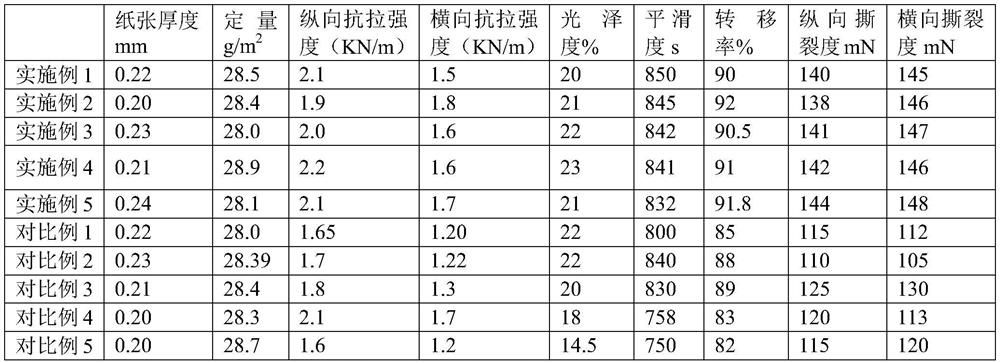Preparation method of anti-permeation heat-stable low basis weight transfer printing base paper
A transfer printing base paper and low basis weight technology, applied in the pulp beating method, pulp beating/refining method, special paper, etc., can solve the problems of low basis weight, poor universality, waste of resources, etc., and reduce the generation of small broken fibers , enhance strength, increase the effect of fiber bonding area
- Summary
- Abstract
- Description
- Claims
- Application Information
AI Technical Summary
Problems solved by technology
Method used
Image
Examples
preparation example Construction
[0042] A preparation method of anti-penetration heat stable low quantitative transfer printing base paper, comprising the following preparation steps:
[0043] (1) Preparation of pulp: mix and beat raw material pulp and additives to prepare mixed pulp; raw material pulp contains 20-40% long-fiber bleached coniferous wood pulp and 60-80% short-fiber bleached broadleaf Pulp; additives and their dosages are: degassing agent, the dosage per ton of paper is 0.5-0.8kg; defoamer, the dosage per ton of paper is 0.3-0.6kg.
[0044] The preparation process of fibers in raw material slurry includes:
[0045] 1) Preparation of long-fiber pulp: the bleached softwood long-fiber wood pulp with a fiber length of 3-3.5mm is pulverized by a hydraulic pulper and transferred to the knocking pool, and then passed through a double-disk refiner and transferred to long-fiber pulp. Tap the back pond, and control the beating power to 160-180kwh, the beating concentration to 3.7-4.0%, and the beating d...
Embodiment 1
[0056] A preparation method of anti-penetration heat stable low quantitative transfer printing base paper, comprising the following preparation steps:
[0057] (1) Prepare slurry: mix and beat raw material slurry and auxiliary agents to prepare mixed slurry; raw material slurry contains 30% long-fiber bleached softwood pulp and 70% short-fiber bleached hardwood pulp; auxiliary agent And its dosage is respectively: degassing agent, the consumption per ton of paper is 0.65kg; defoamer, consumption per ton of paper is 0.45kg.
[0058] The preparation process of fibers in raw material slurry includes:
[0059] 1) Preparation of long-fiber pulp: the bleached softwood long-fiber wood pulp with a fiber length of 3-3.5mm is pulverized by a hydraulic pulper and transferred to the knocking pool, and then passed through a double-disk refiner and transferred to long-fiber pulp. Tap the back pond, and control the beating power to 170kwh, the beating concentration to 3.9%, and the beating ...
Embodiment 2
[0069] The difference from Example 1 is that a method for preparing an anti-penetration thermally stable low-quantity transfer printing base paper includes the following preparation steps:
[0070] (1) Preparation of slurry: mix and beat the raw material slurry and auxiliary agents to prepare a mixed slurry; the raw material slurry contains 25% long-fiber bleached softwood pulp and 75% short-fiber bleached hardwood pulp; auxiliary agent And its dosage is respectively: degassing agent, the consumption per ton of paper is 0.65kg; defoamer, consumption per ton of paper is 0.45kg.
[0071] The preparation process of fibers in raw material slurry includes:
[0072] 1) Preparation of long-fiber pulp: the bleached softwood long-fiber wood pulp with a fiber length of 3-3.5mm is pulverized by a hydraulic pulper and transferred to the knocking pool, and then passed through a double-disk refiner and transferred to long-fiber pulp. Tap the back pond, and control the beating power to 170k...
PUM
| Property | Measurement | Unit |
|---|---|---|
| length | aaaaa | aaaaa |
| water absorption | aaaaa | aaaaa |
| length | aaaaa | aaaaa |
Abstract
Description
Claims
Application Information
 Login to View More
Login to View More - R&D
- Intellectual Property
- Life Sciences
- Materials
- Tech Scout
- Unparalleled Data Quality
- Higher Quality Content
- 60% Fewer Hallucinations
Browse by: Latest US Patents, China's latest patents, Technical Efficacy Thesaurus, Application Domain, Technology Topic, Popular Technical Reports.
© 2025 PatSnap. All rights reserved.Legal|Privacy policy|Modern Slavery Act Transparency Statement|Sitemap|About US| Contact US: help@patsnap.com

